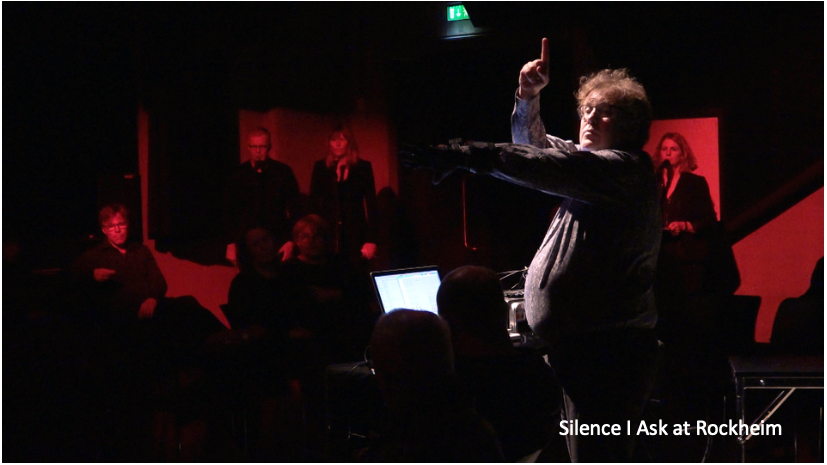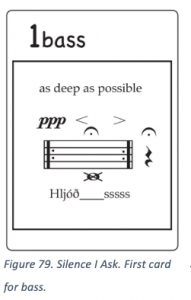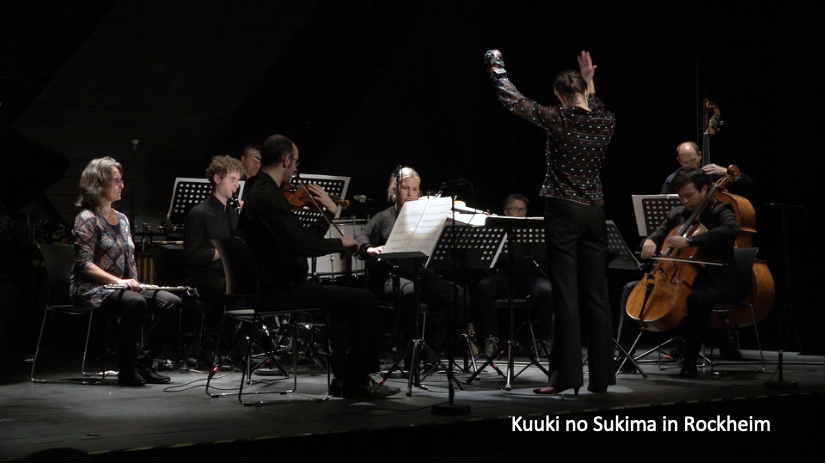ConDiS – The Final Artistic Research Concert

The final Artistic Research Program concert took place on November 3, 2018, at Dokkhuset in Trondheim under the name “Bridging the Gap.” The program consisted of three compositions by the author: Silence I Ask(2013) for 14 voices and live computer-generated sounds, Sononymusfor Flute(1998-2000) for flute and computer-generated sounds, and finally Kuuki no Sukima(2017/18) for 9 instruments, interactive conductor, and live computer-generated sounds.
A video recording of the whole concert can be found at:
https://vimeo.com/300730209/8577fb29d9
Two of these works—Silence I Ask and Kuuki no Sukima—were selected as they clearly illustrate two different functionalities of the ConDiS system. The first shows a possible use of ConDiS for conducting and performing a semi-improvised work. The latter demonstrates a possible use for the system in conducting a performance of a through-composed concert work. The third piece, Sononymus for Flute, was chosen to provide a historical perspective as it presents the oldest synchronization method of mixed music performance: the fixed media/playback where the performer follows a written score of a fixed prerecorded audio file(s). I consider it to be a good example of the problem I have solved with the design of the ConDiS system.
Silence I Ask
The first work featured on the program was a revised version of Silence I Ask for voices, interactive conductor, and live electronics. Originally written in 2013 and premiered that same year at the Rockheim museum in Trondheim, the new version included an interactive conductor using the ConDiS system.
The stage setup is such that the singers form a circle around the audience in groups of two with a conductor located in the middle of the audience. With one microphone per voice, the voices are transformed using a custom-made amplitude envelope follower. It analyzes the vocal loudness and feeds them using real-time digital signal processing (DSP) to a surround loudspeaker arrangement.

The written score consists of fifty-two cards divided into four voice groups, soprano, alto, tenor, bass, with each voice of a group holding a stack of thirteen cards numbered from 1 to 13—each card containing written information conveying musical ideas that performers follow or improvise around. The conductor’s job in the original version is then to signal (cue) when to move from one card to the next and to adjust the volume of the voices and live electronics through conducting exformation. In this, the electronic sound level is a direct consequence of the volume of the voices.
As I stood there during the performance in 2013, conducting on a podium in the middle of the audience, the need for the ability to conduct and control the electronics became evident. What if I could use my conducting gestures to mix the sonic balance, bring the electronic volume up and down, change its timbre, and move it around the hall? I felt an urgent need to create a conducting tool such as would become ConDiS.
 The revised version of Silence I Ask did precisely that. Using the ConDiS system, I managed to add those features that I so urgently wanted during the 2013 performance. Using a mixture of sign language and arm gestures I was able to affect and control the computer-generated sound while conducting the performing voices. Making an OK sign activated volume control and moving my left arm up increased the volume, while a downward motion would decrease the volume. A thumbs up signal followed by a twist of the arm activated and enabled the panning function allowing control of the spatial location of the computer sound. A little-finger up sign along with different finger combinations then allowed the selection of different sound effects. This sound effect could then be controlled by different left-hand movements.
The revised version of Silence I Ask did precisely that. Using the ConDiS system, I managed to add those features that I so urgently wanted during the 2013 performance. Using a mixture of sign language and arm gestures I was able to affect and control the computer-generated sound while conducting the performing voices. Making an OK sign activated volume control and moving my left arm up increased the volume, while a downward motion would decrease the volume. A thumbs up signal followed by a twist of the arm activated and enabled the panning function allowing control of the spatial location of the computer sound. A little-finger up sign along with different finger combinations then allowed the selection of different sound effects. This sound effect could then be controlled by different left-hand movements.
An example of an effect control could be as follows: Begin pointing the little finger of the left hand (the hand wearing the glove) straight out, and then extend a three-finger combination (index, middle, and ring finger) to activate the low pass filter effect. Then open the filter by turning the hand to the right, and close it by turning the hand to the left. To control the amplitude of the effect, an up/down motion of the left arm is needed.
Reflections
Reflecting on the performance, I felt quite pleased; technologically it went well, and aesthetically I was satisfied. I really could feel how my conducting gestures controlled the overall interplay of the voices and the electronics. The feeling of being able to mold and sculpt the electronic sounds and at the same time conduct the performing voices was unexplainable. After a rather cautious start, I grew more enthusiastic and enjoyed improvising with a variety of gesture variations as I began to feel as though I were part of the whole.
Although the ConDiS system successfully met my expectations, it is far from being flawless. The fact that I was conducting a semi-improvised performance meant I did not have to follow a through-composed score, which gave me a lot of freedom. It allowed me to concentrate more on the sound-sculpting factor. By this I mean I was able to play with the sound on the spot, unbound by tight synchronization with the composed score. However, there are many things I would have liked to be simpler and somewhat more musical. I found the need for a computer screen to “see” what action/actions were active was a disturbance that needed eliminating or at least minimizing. Having to use a special sign language in the form of finger combinations to activate/deactivate certain features can also be rather complicated. As mentioned on page. 126, it can become confusing keeping track of which controller you have activated or deactivated, which effect type you have increased/decreased in volume, etc. Although the freedom of improvisation means these moments of confusion are hardly audible or recognizable to the audience, a better solution would certainly be a benefit to the ConDiS system.
Stage Setup
The stage setup, with the singers located around the hall and the conductor located in the center, had a considerable impact on the audience’s musical experience. It greatly improved the audience’s ability to follow the interaction between the conductor’s gestures and the apparent outcome from the speakers located around the hall. Although the singers did complain about not hearing the overall outcome, namely what the other groups of singers were singing, they quickly got used to it during the few rehearsals they did have in the hall. Once again, we were confronted with the issue of limited rehearsal time for mixed music performance.
Although the conductor cannot face all the performers at the same time because they are situated all around him, it did not seem to cause any confusion, as the conductor turns to the group he needs to instruct. When the conductor needs to make contact with all the performers at once, such as when there is a change of performance cards, he raises his arms, makes a sign (finger sign), and turns in place, making sure that all performers are in contact.
I must underline that even though I consider the first performance of Silence I Askin 2013 to have been an important stepping stone toward the idea of ConDiS, the ConDiS research project has not been built with an emphasis on this type of performance. The ConDiS system is built for conducting through-composed mixed music, although it has proven to be very useful for semi-improvised or improvised performances as well. As such, the premiere of Silence I Ask using ConDiS for interactive conducting proved to be an experience of a certain significance, an experience that sparked ideas for future development and compositions.
Sononymus for Flute
Sononymus for flute and electronics represents one of my earliest works in the field of mixed music. I decided to place it on the program for two main reasons. The first is purely aesthetic, since it is a work of personal significance, having been written for and dedicated to the birth of my first child. The second reason was its historical significance since it uses the earliest type of synchronization strategy in mixed music, the fixed media/playback. In writing about the piece on page 16, I mention the constraint presented by having the performer following a fixed playback: “I felt the performer was constrained since he had to follow the CD player no matter what.” I explain how players develop their own ways of finding sounds or signals to use as cues to keep in sync with the CD player. My decision to present this work was motivated by a desire to give the audience an opportunity to listen to the “old,” constrained synchronization method. Surprisingly the musician had not only learned and marked some cues, but also had them timed. By using a stopwatch on a mobile phone, the synchronization remained fairly accurate, hence the constraints of fixed playback were hardly noticeable.
Kuuki no Sukima
The final work of the concert, Kuuki no Sukima, was being performed for the sixth time by Trondheim Sinfonietta under conductor Halldis Rønning. The last previous performance of the work was in Copenhagen at the beginning of February, which was about 9 months after the performance before that. Initially, I had asked for three days in advance to prepare and rehearse for the final concert, but for various reasons, it had not been possible. As previously discussed, mixed music’s Achilles heel is the difficulty associated with getting enough rehearsal time, plus the expenses of adequate setup for more than one day. We had to face that fact that we had to prepare as well as possible with very little time. This by itself was an opportunity to prove that the ConDiS system is sufficiently simple and stable to use, which was the initial aim of the ConDiS project.
Several performers from the Nordic Tour were not available and had to be replaced. For that reason, a great part of the rehearsal time involved achieving the right sonority and incorporating these new players into the artistic interpretation of the work. The whole ConDiS system was working well during the rehearsal and I found it noteworthy how skilled and confident in using it the conductor had become. Therefore, it was possible to practice the work without any interference from technical or technological problems. That way we were able to place the main emphasis on artistic progress and interpretation. However, this did not allow for the time for the careful monitoring setup that I was originally hoping for with the aim of improving the relationship between instruments and electronics. The same was also true for the conductor, who did not have access to the monitor setupI was hoping for. I had asked for a monitor located at her feet but had to settle with monitors placed behind and above the ensemble which faced downwards onto the stage. Thus, the performers and the conductor were better able to hear the overall electronic sounds than they had been before.
Reflections
Besides not getting the rehearsal time that I was expecting, this sixth performance exceeded all the other performances in both sonic quality and aesthetic interpretation. From the beginning it was obvious that the conductor was in full control, she was relaxed yet focused on her conducting of both the instrumental and electronic sounds. The fact that the piece had had time to settle definitely had a positive effect. This was reflected in a more playful approach from the performers. The result was a performance where the music enjoyed the space, the breathing room, so to speak, that was necessary for it to flourish. The overall sound quality was better than before due to changes made both in microphone setup and in the form of a software upgrade, including a totally new plugin for surround mixing. Finally, the Rockheim music hall, with its square shape, high ceiling, and dark, raw concrete, was a perfect setting for this type of musical performance. This is something I knew beforehand, hence the choice of location.
In spite of the excellent performance, some things could have gone better. With respect to my artistic tastes, I would have preferred more variation in the volume levels of the electronics. The conductor chose to keep the volume somewhat loud all the time, which sometimes caused the details of the sonic environment to disappear. But this experience is precisely what the ConDiS system allows: the conductor is able to make decisions and interpret the written composition herself. It is precisely these aspects that fascinate me, these humanistic variants that arise from the interpretation of the music performance from one person to another. As a composer, I find this exceptionally fascinating because I am not interested in carving my composition in stone. This statement may sound like a contradiction since, on the other hand, I want to write through-composed compositions. But as I have emphasized before, I enjoy writing musical ideas as accurately as I want, keeping in mind that inaccuracies can be a matter of accuracy, and then allowing the performer to add his musical interpretation. That is what makes for the interesting musical interplay between the composer’s score and the performer. It is exactly this personal interaction that turns music into a musical adventure.
Stage Setup
Having performed two works with totally different setups, one with performers surrounding the audience and the other staged in the classic performance style on stage, prompted me to think about the importance of the stage setup. Surely the intention behind the creation of ConDiS and therefore the composition Kuuki no Sukimawas solely to experiment with the new conducting tool, the ConDiS, in a very narrow way. This more limited framework would test if it was possible to use ConDiS in the “classic” stage setup.
In my opinion, this experiment was successful, and I believe I achieved acceptable results. But I have experienced a strong desire to expand the horizon. What if the ensemble is staged differently? What if the musicians are located further apart from each other? What if they are staged all over the hall, like in Silence I Ask? What if…? These are all questions that challenge my thinking following the experience of the ConDiS closing concert. These are all questions for which I will have to find answers in future compositions.
